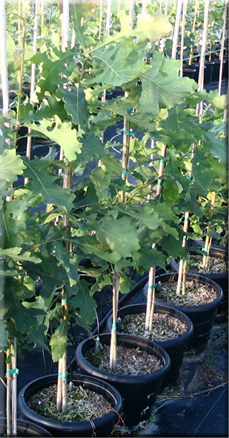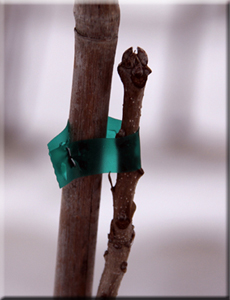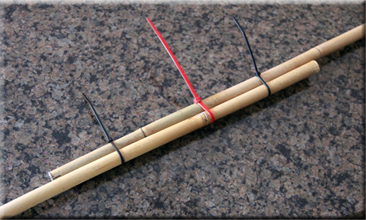
Figure .1
If a tree needs staking push the stake straight into the ground close beside the tree but not in contact with the trunk. The space between the tree and the stake will allow for growth. The same procedure is used whether the plant is in a container or planted in the ground.
Nursery-grown trees often need staking in order to ensure a straight trunk and to promote good branching. Your tree may have a stake with it that lent support during its rapid growth in the nursery. As a result of transport or the planting process the tree may have come loose from its stake and should be retied. Further, as the tree increases in height, it is a good idea to continue to support this soft growth so that it is not broken off or damaged by strong winds. Continue staking for another season or until the stake rots off at the base. If at planting time the tree appears to be well supported by its trunk, remove the stake entirely and any tying tape that may still remain. If the tree seems to lean despite being securely planted in the soil follow the instructions below to stake it.
If the tree needs staked please follow the instructions below:
Materials Needed:
- Bamboo stake – 6′ length is good to allow for growth; OR
- ½” conduit (available in 10′ lengths at the hardware store)
- Vinyl tying tape (available at your local garden center)

Figure 2.
When tying a tree to the stake it is important to leave space between the trunk and the stake. This provides for growth and more importantly it allows the tree to flex in the wind which builds trunk caliper.
Drive the stake straight into the ground right beside the trunk, deep enough to lend support to the trunk. (Figure 1). The stake should be pointed straight up even if the tree is planted on an incline. Using plastic or vinyl plant tying tape tie the tree to the stake loosely (Figure 2). Loosely is defined as leaving enough space to put a pencil between the tree and the stake. The idea is this: the tree needs to be able to move while on the stake. As the wind blows it causes the tree to bend slightly and this gentle flexing builds caliper (thickness) in the trunk. Caliper growth is a response to the flex caused by the wind, so do not tie the tree so tightly to the stake that it cannot move. Also, tying loosely leaves room for future caliper growth. The reason bamboo or conduit works well as a stake is because it allows the tree to flex in the wind even when it is tied. Do not use a stake that is so rigid (like a metal fence post) that it does not allow the tree to flex.
In the nursery we tie every 9 – 12” or so, but that can vary widely. For example, if the tree is growing straight and has a good caliper trunk we may only tie it every 24”. You need only tie frequently enough to keep the tree straight and the new growth supported.
If you want to further support the tree using wires and wooden or metal stakes driven into the ground, we recommend that you wrap the wires around the bamboo stake instead of around the trunk. This is generally unnecessary, but may be useful if the tree tends to tip after it is planted. If the tree tends to tip or rock in its planting hole it can impede rooting into the soil so securing it with wire and wooden stakes will help get it established more quickly.
Sometimes the bamboo stake will rot off beneath the soil level because it is in constant contact with moisture. If the tree is still well-tied to the stake, push the remaining stake back into the ground. If the bamboo is now too short, you can easily add another length of bamboo to the original stake using cable ties (Figure 3). If the tree seems stout and supports itself, then remove the stake completely along with any tying tape that may remain.

Figure 3.
Here cable ties are used to secure two bamboo together
to make a longer one.